
NPS / Joe Bruce Much of Devils Tower National Monument is forested. Although several types of trees are found here, the dominant species is ponderosa pine. These pine forests are dotted with juniper, aspen, and bur oak trees. Ponderosas stand like ancient sentinels above them all. Ponderosa PineThe ponderosa pine is found from Mexico to Canada. They can grow to over 100 feet tall and live more than 300 years. Like many conifers, they keep their green needles all year long; from a distance, however, these dark pines appear almost black, giving rise to the name "Black Hills" (an English translation of the Lakota name "Paha Sapa").Ponderosa forests provide habitat for many species, including red squirrels, porcupines, bobcats, nuthatches, woodpeckers, bullsnakes and more. Commercially, these trees are used for many types of lumber and wood products. Outside of Devils Tower National Monument, huge areas of the Black Hills are managed by the US Forest Service to conserve the resources and recreational opportunities we derive from these forests. These conifers are identified by thick, flaky bark which can be a brown to orange-red color. They have a sweet smell that reminds people of vanilla or butterscotch. While you can catch the scent strolling through the forest, it is best to stick your nose right into the bark and breathe deeply! As ponderosas mature, their lower branches fall off. This adaptation, along with the thick bark and the tree's sap, make it fire tolerant. Occassional fires help keep the forest canopy open and recycle the debris on the forest floor. Enjoy the ponderosa forest at Devils Tower by walking the Tower Trail. 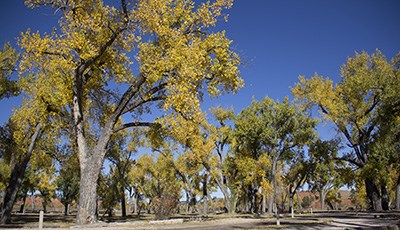
NPS Plains CottonwoodIn contrast to the pine forested slopes of the park, one can walk beneath ancient cottonwood trees in the park campground. These deciduous trees are found along rivers and wetlands throughout the great plains region. Mature trees have deeply furrowed bark and can have a trunk diameter of nearly six feet! With a normal lifespan of 100 years, they can live two to four times longer under good conditions.Cottonwoods are named for their seed dispersal, which occurs in early summer. Cotton-like strands waft through the air and are known for clinging to almost any surface they contact. The spade-shaped leaf turns a beautiful golden color by late summer. The views of the river valley along Red Beds Trail are quite breathtaking thanks to the many cottonwoods which follow the meanders of the waterway. Unfortunately, due to outside river management started in the 1950s, the cottonwoods in the park are slowly dying without new ones growing to replace them. These trees rely on periodic flooding for germination and long-term health; after Keyhole Dam was built in 1952, major flooding of the Belle Fourche River no longer occurs. While this does protect the campground itself, the impacts to the ecology have become more noticeable with time. 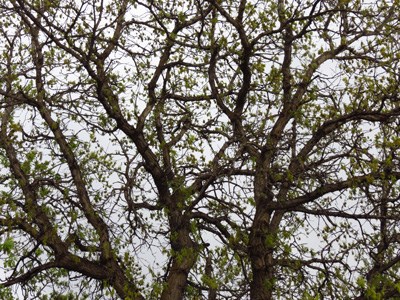
NPS / Michael Wheeler Bur OakThe only native oak species in the region is bur oak. Smaller than eastern oak species, this tree can appear shrub-like in its early stages of growth. Even mature trees display this scraggly appearance in their branches. The acorns they produce are a vital food source for fox squirrels, turkey, deer, and many other creatures.Like cottonwoods, bur oaks thrive in open space along waterways. The trees in the park's picnic area are bur oak. Look for red-headed woodpeckers flying between the trees, or a great-horned owl perched silently in the upper branches. Bur oak can also be seen on the Joyner Ridge Trail or along the northern section of the Tower Trail. 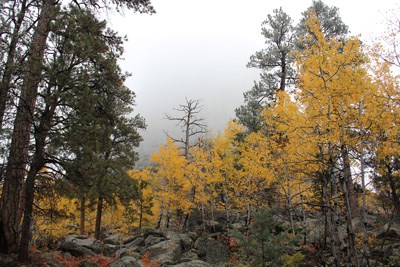
NPS / Chris Racay Quaking AspenThe aspens are a pioneer tree species, growing in dense stands or clusters. They prefer open sunlight and are most common around the boulder field on the south and west faces of the Tower. In the Black Hills, aspen rarely grow more than 30 feet tall, or live longer than 50-60 years.The name derives from the appearance of the leaves in a breeze, which tremor rapidly and flash in the sunlight (seeming to "quake"). Tender leaves and young trees provide an important food source for many grazers. The bright yellow colors in fall make a stunning contrast to the green needles of the ponderosa pine. The bark of the aspen tree is mostly white, with dark brown furrows or scars throughout the tree. 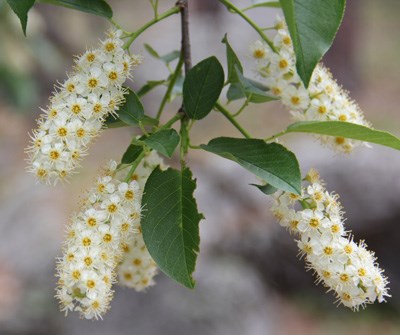
NPS / Joe Bruce ChokecherryThe chokecherry is a shrub-like tree that often grows in thickets. This is seen around the main parking area outside the Visitor Center, and in a few places along the park road. The trees bloom a cluster of white flowers in May which fill the air with a sweet fragrance. They also attract pollinating bees. Standing near a chokecherry in May, one can almost feel the buzzing of the insects. By late July or August the berries have developed and will turn a deep purple or black color.Chokecherry has long been a staple food for humans in the region. Today people still utilize it to make wines and jellies. Animals also enjoy the berries. The fall webworm moth (not to be confused with the invasive tent caterpillar or gypsy moth) builds nests in chokecherry trees, which in turn feed many insectivorous birds like the American robin. Other TreesCommon tree species not detailed on this page include the green ash and Rocky Mountain juniper.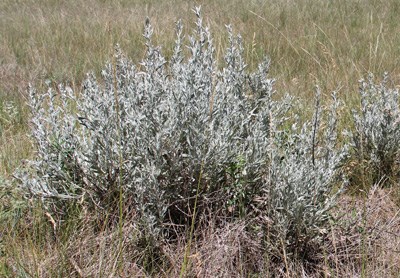
NPS / Joe Bruce ShrubsThe most common shrub on the Great Plains is sagebrush, which comes in many different varieties. Silver sage grows large and conspicuous, as does big sagebrush. The latter has a Wyoming subspecies; although common, the only place within the park to find big sagebrush is on the summit of Devils Tower! The sages which grow on North American prairies are not the same as the sage in your kitchen. Although fragrant (and technically edible), the various wild sages are not commercially used. It is an important ceremonial plant. Many indigenous people still use sage today for prayer and purification ceremonies.Dogbane is a common shrub along the Tower Trail which has tiny, light pink flowers throughout the summer. Rabbitbrush can be seen in prairie dog town along the park road, growing large and flowering yellow in early fall. Shrubs like these provide vital shelter for smaller animals to hide from predators, or for predators to stalk their prey! |
Last updated: April 24, 2025
